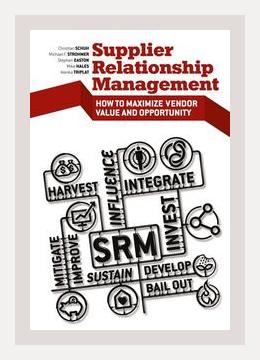Operations and Supply Chain ManagementLogistics
**
I. Introduction
Jonathan O’Brien’s book “Supplier Relationship Management: How to Maximize Vendor Value and Opportunity” delves into the intricacies of managing supplier relationships to maximize their value and opportunities for businesses. It serves as a practical guide for procurement professionals, shedding light on strategic approaches, methodologies, and practical examples to enhance supplier collaboration and performance.
II. Understanding Supplier Relationship Management (SRM)
Definition and Importance
O’Brien defines Supplier Relationship Management (SRM) as a strategic approach that deals with the systematic management of an organization’s interactions with the companies that supply goods and services. SRM is crucial in today’s interconnected global market, where robust supplier relationships can lead to competitive advantages.
(Action: Invest time and resources in understanding the strategic value of SRM and consider designating a team to focus on supplier management.)
Major Benefits of SRM
The book emphasizes several benefits, including cost reduction, improved quality, innovation, and risk mitigation. By fostering closely-knit relationships, businesses can leverage supplier insights to drive continuous improvement and innovation.
(Action: Conduct a cost-benefit analysis to identify the potential financial and operational benefits of implementing SRM in your organization.)
III. The SRM Process Framework
Segmentation
Segmentation of suppliers is critical for efficient SRM. O’Brien recommends categorizing suppliers into strategic, important, and transactional based on their impact on the business.
(Action: Implement a supplier segmentation matrix to categorize suppliers and tailor relationship strategies accordingly.)
Supplier Development Programs
These programs involve collaborative efforts to help suppliers improve their capabilities, such as through joint problem-solving, training, and technology transfer.
(Action: Develop and implement a supplier development program by identifying areas where your key suppliers need support and establishing specific initiatives to help them improve.)
Performance Measurement
Effective SRM requires regular performance measurement and feedback. O’Brien details metrics such as delivery reliability, quality, and innovation contributions.
(Action: Create a comprehensive supplier performance evaluation system that includes quantifiable metrics and regular performance reviews.)
IV. Building Effective Supplier Relationships
Trust and Collaboration
Trust is the cornerstone of effective supplier relationships. O’Brien underscores the importance of transparency, open communication, and mutual respect.
(Action: Foster an environment of trust by being transparent with performance data and engaging in regular, open dialogues with your suppliers.)
Joint Ventures and Alliances
Strategic alliances and joint ventures can amplify the benefits of SRM. O’Brien provides examples like Dell leveraging its close partnerships with suppliers to streamline its supply chain.
(Action: Explore opportunities for forming strategic alliances or joint ventures with key suppliers to enhance collaborative innovation and market responsiveness.)
V. Strategic Procurement and SRM Integration
Aligning Procurement and Business Goals
Aligning procurement strategies with broader business goals ensures that SRM initiatives are geared towards the overall organizational success. O’Brien recommends a holistic approach where procurement is seen as a strategic partner.
(Action: Integrate procurement strategies with the company’s business objectives through regular strategy meetings and joint goal-setting with executive leadership.)
Supplier Scorecards and Balanced Scorecards
These tools help in maintaining alignment by providing a structured approach to measuring supplier performance against key business objectives.
(Action: Implement supplier scorecards to regularly track and communicate performance metrics aligned with your organizational goals.)
VI. Continuous Improvement and Innovation
Lean and Six Sigma
Incorporating Lean and Six Sigma methodologies can drive continuous improvement in supplier processes. O’Brien demonstrates this with examples of companies achieving significant operational efficiencies through these practices.
(Action: Train your procurement team and suppliers in Lean and Six Sigma principles and launch joint improvement initiatives.)
Encouraging Supplier Innovation
O’Brien highlights the need to create a culture that encourages and rewards innovative solutions from suppliers. He discusses Procter & Gamble’s “Connect + Develop” program as a case in point.
(Action: Establish an innovation program that includes incentives and recognition for suppliers who contribute innovative solutions that benefit your business.)
VII. Risk Management in SRM
Identifying and Assessing Risks
Risk management is an integral part of SRM. O’Brien outlines methods for identifying, assessing, and mitigating supplier-related risks.
(Action: Conduct a thorough risk assessment of your supply chain and develop contingency plans for high-risk areas.)
Business Continuity Planning
O’Brien stresses the need for robust business continuity plans involving key suppliers to handle disruptions smoothly.
(Action: Collaborate with key suppliers to develop and regularly update joint business continuity plans.)
VIII. Technological Tools and SRM
SRM Software Solutions
Technological tools and software can significantly enhance SRM. O’Brien points out the benefits of using SRM platforms for better data management and collaboration.
(Action: Evaluate and implement suitable SRM software that integrates with your existing systems to streamline supplier management processes.)
E-Procurement and Digital Collaboration
Digital tools such as e-procurement platforms facilitate better collaboration and efficiency. O’Brien gives examples of companies benefiting from real-time data exchange and automated procurement processes.
(Action: Invest in e-procurement platforms that facilitate seamless interactions with suppliers and automate routine procurement activities.)
IX. Developing SRM Competencies
Training and Development
O’Brien highlights the importance of continuous training and skill development in SRM. He suggests creating development programs for procurement teams.
(Action: Establish SRM training programs for your procurement staff to enhance their skills in relationship management, negotiation, and strategic sourcing.)
Cross-functional Teams
Building cross-functional teams can enhance SRM by bringing diverse perspectives and expertise to supplier interactions.
(Action: Form cross-functional SRM teams including members from procurement, R&D, logistics, and finance to work collaboratively with suppliers.)
X. Conclusion
Jonathan O’Brien’s “Supplier Relationship Management: How to Maximize Vendor Value and Opportunity” offers a comprehensive guide to mastering SRM. By implementing strategic segmentation, fostering trust and collaboration, integrating innovative practices, managing risks, leveraging technology, and developing competencies, organizations can unlock substantial value and opportunities from their supplier relationships.
In practice, these steps involve detailed planning, regular assessment, and continuous improvement, making SRM not just a function but a strategic asset contributing directly to organizational success.
By taking these actionable steps, businesses can transform their supplier relationships into powerful alliances that drive mutual growth, innovation, and competitive advantage.
